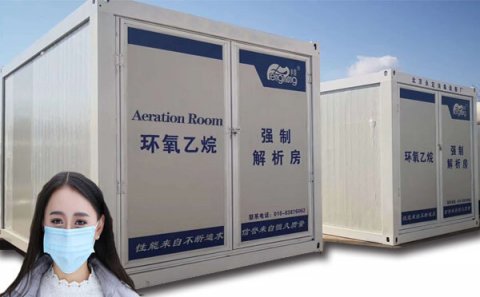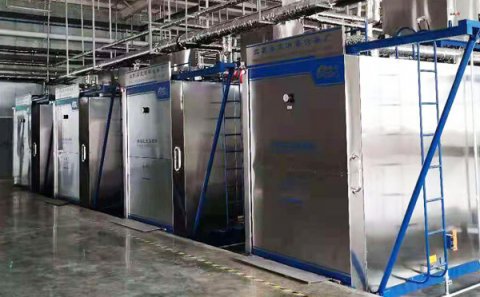
Ethylene oxide is a gas at above 10.73 ℃, which is heavier than air, easily liquefied, the liquid is colorless and transparent, structure formula is H2C - CH2= 0. At 10 ℃ for 0.882 specific gravity, volatile when there is a smell of ether, can dissolve in water and organic solvents.
The method of reducing EO residue should be established to make the sterilized products meet the requirements of iso10993-7.
The method of reducing EO residue should be established to make the sterilized products meet the requirements of iso10993-7.
It is necessary to control EO residue in medical devices after EO processing by proper ventilation. It is important to consider the position of the product used for EO residue test in loading, which should be the most challenging location for EO removal.
Local environmental, health and safety regulations may require additional worker protection measures when handling sterilized products, even when dealing with EO residues that have met iso10993-7 requirements.
The aeration process should be established based upon the most difficult-to-aerate product or product family.
eo molecule can Produce alkylation reaction with carboxyl (-COOH), amino (-NH2), sulfur hydrogen base (-SH) and hydrogen (-OH) which on the Gene protein metabolism necessary in bacterial cells In place of labile hydrogen atoms on above mentioned the various base ,Formingone with hydroxyethyl base (-CH2CH2OH) compounds,Because of this compound damage the essential reaction base which in important microbial metabolic reactions,:Effect of the bacterial enzymes, made microorganism dead.
Existing validation sterilization cycle
A documented conclusion that a new product or a modified product is suitable to be classified into a product family / process type based on the current validation study for achieving the required sal. The conclusion should include or refer to the results of additional tests conducted to supplement the existing validation studies, and the results of further tests (such as residue test, functional test) to confirm and identify the routine release of products in the existing validation sterilization cycle.
evidence or assessment of the bioburden of the product and its resistance relative to the internal PCD.
Comparison results of new or modified products with those of the products that have been verified at present. The comparison results should clearly indicate the complexity, materials, packaging and loading methods of the evaluation products.
Description of product status and provide sterilization status (packaging and loading methods). The specification shall include or refer to the required Sal and evidence or assessment of the suitability of the product for the sterilization process.
specification of a sterilization process
The result of the process definition activities is a detailed specification of a sterilization process. The selection of the sterilization process that is to be used for medical devices should include consideration of all factors that can influence the efficacy of the process. The following should be taken into account:
- range of conditions that can be achieved within the available sterilizing equipment;
- availability of sterilization equipment;
- sterilization processes already in use for other products;
- sterilant to be used (i.e. 100 % EO or EO mixed with diluent gas);
- product limitations (i.e. temperature, humidity, pressure sensitivity);
- requirements for levels of residual EO and/or its reaction products;
- results of process development experiments.
During process definition
During process definition, a manufacturer will use microbiological testing and other analytical tools to help establish an appropriate sterilization process for a medical device.
The sterilization process parameters to be established include:
- a)relative humidity range within the preconditioning room (if used);
- b)temperature range within the preconditioning room (if used);
- c)time set point and range within the preconditioning room (if used);
- d)vacuum and pressure levels and rates of pressure changes in the sterilization chamber;
- e)if used, confirmation that chamber recirculation operational during sterilant dwell;
- f)temperature set point and range within the sterilization chamber;
- g)humidity control set point (pressure or %RH) and range within the sterilization chamber environment;
- h)EO and diluent gas (if used) injection pressure set point and range; this will include EO concentration if EO analysis equipment is installed on the sterilization chamber;
- i)EO dwell time;
- j)setting for the in-chamber gas flushing prior to the removal of the load from the sterilization chamber (if used);
- k)temperature set point and range within the aeration room (if used);
- l)time set point and range within the aeration room (if used);
- m)air flow/changes parameters.
NOTE
For medical facilities, for reusable medical devices to be reprocessed in the medical facilities, the manufacturer shall provide validated reprocessing instructions, which are partially based on the process definition. It is then the responsibility of the medical institution to review the document and confirm that it can use its own equipment and sterilization process in accordance with the medical device manufacturer's instructions. Procurement procedures of medical institutions should be required
Before purchasing ethylene oxide sterilized medical devices, the reprocessing instructions should be evaluated to confirm that the device is compatible with the equipment and sterilization process used by the institution. See also ISO 17664.








Comments: